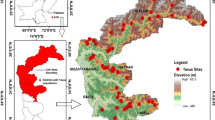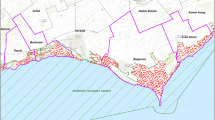The conservation of biodiversity is essential for human survival and quality of the environment. Lakshadweep islands are vulnerable to global change and the representing remnant natural vegetation. Landscape fragmentation, disturbance regimes and biological richness have been studied using geo-spatial techniques. Littoral vegetation is the only natural vegetation type of Lakshadweep islands. Altogether 59 patches of the littoral vegetation occupying an area of 137.2 ha were identified. 58.06% of the littoral vegetation patches belongs to the patch-size class of <5 ha. The remnant natural vegetation surviving with patches of less than 20 ha size indicates severe anthropogenic pressure. The fragmentation of littoral vegetation habitat into smaller isolated patches poses one of the key threats to biodiversity and coastal environment. Phytosociological observations revealed distinct plant communities and presence of invasive species in littoral vegetation. The high disturbance areas accounted for 59.11% area of the total vegetation. The overall spatial distribution of biological richness (BR) in Lakshadweep shows maximum BR at low level (78%), followed by medium (19%), high (2%) and very high (1%). The study emphasises the importance of conserving the remnant natural vegetation, which is critically endangered.





Similar content being viewed by others
References
Anonymous 1991 Pitti Island, Lakshadweep: An ornithological study; Madras Naturalist Society, Madras.
Behera M D and Roy P S 2010 Assessment and validation of biological richness at landscape level in part of the Himalayas and Indo–Burma hotspots using geospatial modelling approach; J. Indian Soc. Rem. Sens. 38 415–429.
Bierregaard R O Jr, Lovejoy T E, Kapos V, dos Santos A A and Hutchings R W 1992 The biological dynamics of tropical rainforest fragments; BioScience 42 59–866.
Broadbent E N, Asner G P, Keller M, Knappa D E, Oliveiraa P J C, and Silvad J N 2008 Forest fragmentation and edge effects from deforestation and selective logging in the Brazilian Amazon; Biol. Conservat. 141 1745–1757.
Census of India 2011 Ministry of Home Affairs, Government of India.
Champion H G and Seth S K 1968 A Revised Survey of the Forest Types of India; Govt. of India Press, Delhi.
Cottam G and Curtis J T 1956 The use of distance measurement in phytosociological sampling; Ecology 37 451–460.
Curran L M, Caniago I, Paoli G D, Astianti D, Kusneti M, Leighton M, Nirarita C E and Haeruman H 1999 Impact of El Nino and logging on canopy tree recruitment in Borneo; Science 286 2184–2188.
Forman R T T and Godron M 1986 Landscape Ecology; John Wiley and Sons, New York.
http://glcf.umiacs.umd.edu/ Accessed on 21st June 2009.
Innes J L and Koch B 1998 Forest biodiversity and its assessment by remote sensing; Global Ecol. Biogeogr. Lett. 7 397–419.
Jha C S, Goparaju L, Tripathi A, Gharai B, Raghubanshi A S and Singh J S 2005 Forest fragmentation and its impact on species diversity: An analysis using remote sensing and GIS; Biodiversity & Conservation 14 1681–1698.
Kempf M 1993 A new way to oversee public’s forests?; American Forests 99 28–31.
Lehmkuhl J F and Ruggiero L F 1991 Forest fragmentation in the Pacific north west and its potential effect on wildlife. Wildlife and vegetation of unmanaged Douglas fir forests; General Technical Report PNW-GTR-285, USDA Forest Service, Pacific North West Research Station, Portland, Oregon, pp. 35–46.
Louisa J M J and Antonio D G 2001 Parametric land cover and land use classifications as tools for environmental change detection; Agr. Ecosyst. Environ. 91 89–100.
Ludeke A K, Maggio R C and Reid L M 1990 An analysis of anthropogenic deforestation using logistic regression and GIS; J. Environ. Manag. 31 247–259.
McGarigal K, Cushman S A and Ene E 2012 FRAGSTATS v4: Spatial Pattern Analysis Program for Categorical and Continuous Maps; Computer software program produced by the authors at the University of Massachusetts, Amherst. http://www.umass.edu/landeco/research/fragstats/fragstats.html.
Murcia C 1995 Edge effects in fragmented forests: Implications for conservation; Trends in Ecol. Evol. 10 58–62.
Prasad P R C, Shringeswara A N, Reddy C S, Nidhi N, Rajan K S, Giriraj A, Murthy M S R, Raza S H and Dutt C B S 2009 Assessment of forest fragmentation and species diversity in North Andaman Islands (India) – A geospatial approach; Int. J. Ecol. Develop. 14(9) 33–46.
Ramachandra T V, Kamakshi G and Shruthi B V 2004 Bioresource status in Karnataka; Renew. Sustain. Energy Rev. 8(1) 1–47.
Ramesh B R, Menon S and Bawa K S 1997 A vegetation based approach to biodiversity gap analysis in the Agastyamalai region, Western Ghats, India; Ambio 26(8) 529–536.
Reddy C S and Roy P S 2011 Plant diversity of Lakshadweep Islands; National Remote Sensing Centre, Hyderabad & Bishen Singh Mahendra Pal Singh, Dehra Dun, ISBN: 978-81-211-0784-6.
Reddy C S 2010 Biodiversity characterization at landscape level using satellite remote sensing and GIS in Lakshadweep Islands; Technical Report, National Remote Sensing Centre, Hyderabad.
Rodriguez J P et al. 2010 Establishing IUCN red list criteria for threatened ecosystems; Conservat. Biol. 25 21–29.
Roy P S, Singh S, Dutt C B S, Jeganathan C, Jadav R N, Ravan S A, Diwakar P G, Tomar S, Tiwari A K, Ranganath B K and Hegde V S 1999 Biodiversity characterisation at landscape level using satellite remote sensing and Geographic Information System; DOS-DBT User Manual, Indian Institute of Remote Sensing, Dehra Dun, India.
Acknowledgements
The work has been carried out under the Biodiversity Characterisation Project of Department of Space and Department of Biotechnology, India. The authors are thankful to Dr V Jayaraman, Former Director, NRSC, Dr V K Dadhwal, Director, NRSC, and Dr P S Roy, Director, IIRS, Dehradun, for facilities and encouragement.
Author information
Authors and Affiliations
Corresponding author
Rights and permissions
About this article
Cite this article
REDDY, C.S., DEBNATH, B., KRISHNA, P.H. et al. Landscape level assessment of critically endangered vegetation of Lakshadweep islands using geo-spatial techniques. J Earth Syst Sci 122, 271–281 (2013). https://doi.org/10.1007/s12040-013-0272-4
Received:
Revised:
Accepted:
Published:
Issue Date:
DOI: https://doi.org/10.1007/s12040-013-0272-4




